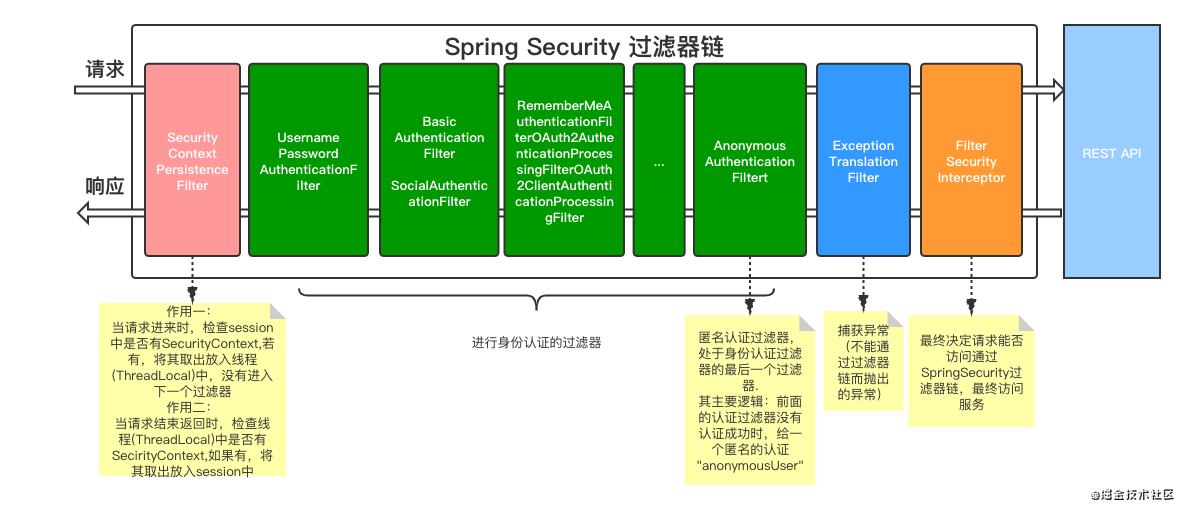spring security前后端分离的认证授权
我的毕设项目是类斗鱼软件开发,所以我为了给我的项目增加亮点,权限认证与授权肯定就不能用之前的过滤器来弄了,现在我决定使用spring security来接管我的项目。具体源码已经上传Github
spring security认证流程
-
用户使用用户名和密码进行登录。
-
Spring Security将获取到的用户名和密码封装成一个实现了Authentication接口的UsernamePasswordAuthenticationToken。
-
将上述产生的token对象传递给AuthenticationManager进行登录认证。
-
AuthenticationManager认证成功后将会返回一个封装了用户权限等信息的Authentication对象。
-
通过调用SecurityContextHolder.getContext().setAuthentication(...)将AuthenticationManager返回的Authentication对象赋予给当前的SecurityContext。
spring security的基本组件与流程
我们首先要知道,spring security是一个一个的过滤器,他的过滤流程是下面这样:
spring security重要组件
UsernamePasswordAuthenticationFilter
首先就是我们的UsernamePasswordAuthenticationFilter,按照我的理解是,只要你在后面的configure函数里面设定了表单登录,你就得走着个过滤器,并且我们一般都会设置那个。
他这个过滤器的关键函数就是attemptAuthentication,源码如下:
public Authentication attemptAuthentication(HttpServletRequest request, HttpServletResponse response) throws AuthenticationException {
if (this.postOnly && !request.getMethod().equals("POST")) {
throw new AuthenticationServiceException("Authentication method not supported: " + request.getMethod());
} else {
String username = this.obtainUsername(request);
String password = this.obtainPassword(request);
if (username == null) {
username = "";
}
if (password == null) {
password = "";
}
username = username.trim();
UsernamePasswordAuthenticationToken authRequest = new UsernamePasswordAuthenticationToken(username, password);
this.setDetails(request, authRequest);
return this.getAuthenticationManager().authenticate(authRequest);
}
}
不算是很复杂,我们看到我们最熟悉的username和password,也就是说,他其实就是一个将请求获取一下用户名和密码的东西。
所以,我自定义了这个文件,代码如下:
public class CustomAuthenticationFilter extends UsernamePasswordAuthenticationFilter {
@Autowired
@Override
public void setAuthenticationManager(AuthenticationManager authenticationManager) {
super.setAuthenticationManager(authenticationManager);
}
public Authentication attemptAuthentication(HttpServletRequest request, HttpServletResponse response){
JSONObject json = null;
try {
json = ServletUtils.getRequestJsonObject(request);
} catch (IOException e) {
throw new AppException("服务器错误,请重试");
}
// 获取json值
String username = json.getString("username");
String password = json.getString("password");
if (username == null) {
username = "";
}
if (password == null) {
password = "";
}
UsernamePasswordAuthenticationToken authRequest = new UsernamePasswordAuthenticationToken(username, password);
this.setDetails(request, authRequest);
return this.getAuthenticationManager().authenticate(authRequest);
}
}
这个ServletUtils请具体看我的源码,具体作用就是将请求过来的参数转化成为Json对象
登录成功和登录失败以及未登录
- 登陆失败:AuthenticationFailureHandler
- 登陆成功:
AuthenticationSuccessHandler - 未登录:AuthenticationEntryPoint
这三个是可以自定义状态返回结果,都需要自定义
WebSecurityConfigurerAdapter
我们将上面的东西都写完了,最后就是要组装了,集成上面这个类,实现configure方法,就可以做到这一点。
@Configuration
public class SecurityConfig extends WebSecurityConfigurerAdapter {
@Autowired
LoginSuccessHandler loginSuccessHandler;
@Autowired
LoginFailedHandler loginFailedHandler;
@Autowired
AuthenticationEntryPoint anonymousAuthenticationEntryPoint;
@Bean
public UserDetailsService userDetailsService(){
return new UsrServiceImpl();
}
// @Autowired
// UsernamePasswordAuthenticationFilter customAuthenticationFilter;
@Bean
CustomAuthenticationFilter customAuthenticationFilter() throws Exception {
CustomAuthenticationFilter filter = new CustomAuthenticationFilter();
filter.setAuthenticationSuccessHandler(loginSuccessHandler);
filter.setFilterProcessesUrl("/loginUsr");
filter.setAuthenticationManager(authenticationManager());
filter.setAuthenticationFailureHandler(loginFailedHandler);
return filter;
}
@Bean
@Override
protected AuthenticationManager authenticationManager() throws Exception {
return super.authenticationManager();
}
@Bean
public BCryptPasswordEncoder getPW(){
return new BCryptPasswordEncoder();
}
@Override
protected void configure(AuthenticationManagerBuilder auth) throws Exception {
auth.userDetailsService(userDetailsService());
}
@Override
protected void configure(HttpSecurity http) throws Exception {
http.csrf().and().cors().disable();
http
.authorizeRequests()
.antMatchers("/authTest").permitAll()
.anyRequest().authenticated()
.and()
.and()
.formLogin()
// .loginPage("/login")
.loginProcessingUrl("/loginUsr")
.permitAll();
http.exceptionHandling().authenticationEntryPoint(anonymousAuthenticationEntryPoint);
http.addFilterAt(customAuthenticationFilter(),UsernamePasswordAuthenticationFilter.class);
}
@Override
public void configure(WebSecurity web) throws Exception {
// 这个会在上面的过滤器执行之前执行
web.ignoring().antMatchers("/loginUsr");
}
}
configure里面的注意事项
这个我单独拿出来说,因为特别重要
-
由于我们不需要Spring security自带的登录页面,所以.loginPage()我们不需要写!!
-
这个.loginUsr我们不需要写一个controller,因为我们在访问这个网址的时候,spring security自动将请求进入这几个过滤器
-
.loginUsr需要在web.ignoring().antMatchers("/loginUsr");这段代码里面放行,而不是用 http.antMatchers里面写!
-
因为我们自定义了UsernamePassword..那个过滤器,所以他的认证管理器如果我们new一个的话,他会直接报错,因为这个时候他自己的认证管理器已经指向不明确了。
